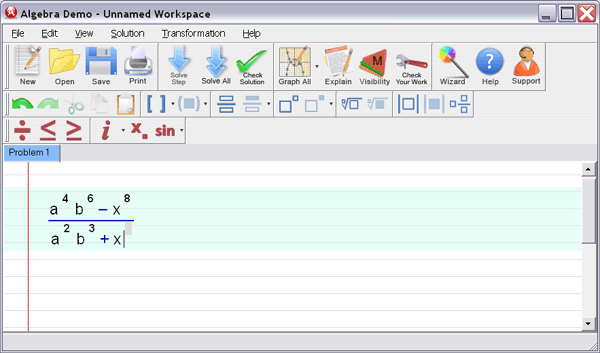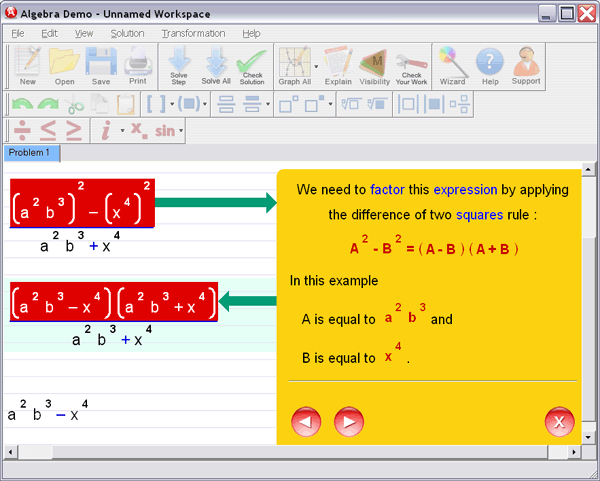BASIC ALGEBRA REVIEW
Assume that letters such as a, b, x, y represent real
numbers , unless otherwise specified.
I.
Subsets of the real numbers: Integers include whole numbers and their
negatives. The rationals include all
integers AND all fractions, and have repeating decimals . Irrationals
(e.g., π ,  , etc.) include all
other , etc.) include all
other
real numbers and have non-repeating decimals. A real number is either
rational or irrational but not both. |
II.
Order: a < b means that a is located to the left of b on the real number
line ; a ≤ b means that either a is to
the left of b, or a and b coincide. 0 is greater than all negative
numbers, and less than all positive numbers . |
III.
Absolute value:  is the distance (on
number line) from a to b, disregarding direction (so the result of is the distance (on
number line) from a to b, disregarding direction (so the result of
an absolute value is always non-negative). If a > b , then
 ; else ; else
 . If . If
b = 0 , then  is the distance from 0
to a. Watch negative signs closely; is the distance from 0
to a. Watch negative signs closely;  but
but  . . |
IV.
Exponents: for a ≠ 0 . Change
negative exponents to positive by exchanging the position of the for a ≠ 0 . Change
negative exponents to positive by exchanging the position of the
associated factors from numerator to denominator or vice-versa; e.g., (note:
do not (note:
do not
exchange any factors that initially have positive exponents!). Other
rules: 
 Fractional exponents are really
radicals: Fractional exponents are really
radicals:  |
V.
Radicals (inverses of exponents): If  then
then  (read “the cube root of 216
equals 6”; note (read “the cube root of 216
equals 6”; note
that the same three numbers 6, 3, 216 appear in both equations, but in a
different order). The small 3
above the radical is the index ; the 216 inside the radical is the
radicand. If the index is 2, it is usually not
written; thus  . Simplify radicals
when possible by factoring; for a cube root, any group of 3 . Simplify radicals
when possible by factoring; for a cube root, any group of 3
identical factors is moved outside the radical and compressed into one
factor; for fourth roots, any group
of 4 identical factors is moved and compressed, etc.; e.g.,
 . . |
VI.
Operations involving radicals: Product
 ; quotient ; quotient sum/difference sum/difference
 (similar to combining like terms );
rationalizing denominators (one term) (similar to combining like terms );
rationalizing denominators (one term)
 ; rationalizing denominators ( two
terms , using conjugate of denominator) ; rationalizing denominators ( two
terms , using conjugate of denominator)
 or or  ;
if an expression ;
if an expression
combines different indices (e.g., a cube root times a fourth root),
convert radicals to fractional exponents
and use exponent rules to simplify (see IV above); result may be
converted back to radicals afterwards. |
VII.
Factoring polynomials: Simplify like terms (if any) and rewrite in
descending-powers order. Then try
methods in the order listed: (1) GCF ; (2) grouping (for four or more
terms); (3) difference of squares, or
sum/difference of cubes (for certain binomials); and (4) trinomial
(“ac”) method. It may be necessary to
apply multiple methods (or repeatedly apply a single method) within a
single expression, e.g.,
 ; the difference-of- squares method
applies twice. ; the difference-of- squares method
applies twice. |
Start solving your Algebra Problems
in next 5 minutes!
 |
 |
 |
|
Algebra Helper
Download (and optional CD)
Only $39.99
|
|
Click to Buy Now:
OR
|
|
|
 |
 |
 |
|
2Checkout.com is an authorized reseller
of goods provided by Sofmath
|
|
Attention: We are
currently running a special promotional offer
for Algebra-Answer.com visitors -- if you order
Algebra Helper by midnight of
December 21st
you will pay only $39.99
instead of our regular price of $74.99 -- this is $35 in
savings ! In order to take advantage of this
offer, you need to order by clicking on one of
the buttons on the left, not through our regular
order page.
If you order now you will also receive 30 minute live session from tutor.com for a 1$!
|
You Will Learn Algebra Better - Guaranteed!
Just take a look how incredibly simple Algebra Helper is:
Step 1
: Enter your homework problem in an easy WYSIWYG (What you see is what you get) algebra editor:

Step 2 :
Let Algebra Helper solve it:

Step 3 : Ask for an explanation for the steps you don't understand:

Algebra Helper can solve problems in all the following areas:
- simplification of algebraic expressions (operations
with polynomials (simplifying, degree, synthetic division...), exponential expressions, fractions and roots
(radicals), absolute values)
- factoring and expanding expressions
- finding LCM and GCF
-
(simplifying, rationalizing complex denominators...)
- solving linear, quadratic and many other equations
and inequalities
(including basic logarithmic and exponential equations)
- solving a system of two and three linear equations
(including Cramer's rule)
- graphing curves (lines, parabolas, hyperbolas, circles,
ellipses, equation and inequality solutions)
- graphing general functions
- operations with functions (composition, inverse, range, domain...)
- simplifying logarithms
- basic geometry and trigonometry
(similarity, calculating trig functions, right triangle...)
- arithmetic and other pre-algebra topics
(ratios, proportions, measurements...)
ORDER NOW!
 |
 |
 |
|
Algebra Helper
Download (and optional CD)
Only $39.99
|
|
Click to Buy Now:
OR
|
|
|
 |
 |
 |
|
2Checkout.com is an authorized reseller
of goods provided by Sofmath
|
|
|
 |
| |
| "It
really helped me with my homework. I was
stuck on some problems and your software walked me
step by step through the process..." |
| C. Sievert, KY
| |
| |
 |
| |
Sofmath
19179 Blanco #105-234
San Antonio, TX 78258
|
Phone:
(512) 788-5675
Fax: (512) 519-1805
| | |



